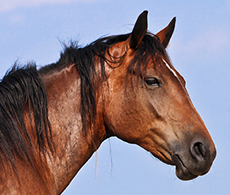
How to spot gastric ulcers in horses
Could your horse have gastric ulcers? A hidden yet common health threat, there are clues that can help you to recognise the condition and ways to manage it.
Has your horse become grumpy recently? Have they developed a habit of snapping when you do up the girth? Or are they struggling to put on weight? If so, they might be suffering from equine gastric ulcers – a prolific, ‘silent’ but painful and potentially life-threatening condition that can affect all types of horse and pony.
‘Equine gastric ulcer syndrome’ is the term used to describe ulcers, lesions and erosions in the horse’s digestive tract. There are two main types of gastric ulcers in horses, but essentially, they are the result of erosion of the stomach lining due to extended exposure to the digestive acids that a horse’s stomach secretes.
Studies show that 90% of racehorses, 63% of performance horses and 37% of leisure horses suffer from ulcers. They are also prevalent in foals – up to 50% will suffer at some point.
Symptoms of gastric ulcers in horses
There are various signs that can help identify gastric ulcers in horses and many ways to manage the condition. Horses can be at risk of gastric ulcers if they are stressed, have a low forage and/or high concentrate diet, an intense exercise regime, or if they have been starved intermittently. Other recognised causes are changes in management and stabling, moving home, or being stabled for prolonged periods. Unfortunately, some horses are just naturally more susceptible to developing ulcers.
The signs to look out for include reduced appetite, weight loss (or difficulty maintaining weight), loose or inconsistent manure due to gut irritation, poor performance, poor condition (including a dull coat), behavioural changes (such as grumpiness, particularly when doing up the girth, and heightened stress), and mild or recurrent colic.
If you are at all worried, get your horse checked out before symptoms escalate, resulting in medical intervention and a claim on your horse insurance policy. Chronic pain and discomfort from ulcers can significantly diminish a horse’s quality of life, and in extreme cases, gastric ulcers can develop to the point where the stomach perforates, which would be fatal.
A definitive diagnosis can only be made by a vet using a video or fibre-optic endoscope (known as ‘scoping’) to look at your horse’s stomach lining.
Preventing gastric ulcers in horses
Prevention is better than cure, so here are ways you can minimise the chances of ulcers forming.
Ulcer-prone horses should never be without food for more than a couple of hours. Always offer forage ad lib – never leave your horse with nothing to eat, even while travelling. A slow-feeder haynet will extend grazing time for stabled horses or if grass is limited.
If your horse doesn’t have much of an appetite for the forage on offer, consider trying small, frequent meals of other high-fibre feeds such as chaff, unmolassed sugar beet or grass nuts. Avoid starchy and sugary feeds – for example, straight grain, coarse mix and molassed compounds.
Alfalfa is thought to buffer stomach acid, due to its high protein and calcium content. Try feeding at least 1kg daily to an average 500kg horse. Corn or rapeseed oil (50-100ml once or twice a day) may also reduce the amount of stomach acid and could increase barrier mucus function.
Fast work or jumping on an empty stomach may cause the acid to splash into sensitive parts of a horse’s stomach lining. A handful of chaff or alfalfa as a snack before tacking up to ride can help protect the stomach from acid during exercise.
Minimise the stress of ulcer-prone horses or ponies with company, limited confinement and either a strict routine or no routine at all (for example, a horse turned out 24/7 in a herd situation). Keep changes in routine to a minimum and try to create the most comfortable environment possible for your horse.
Treatment for gastric ulcers in horses
The most common treatment for gastric ulcers involves dietary changes, stress reduction, and some form of antacid medication which reduces acidity in the stomach and allows the ulcers to heal. Antibiotics and gastro-protectants are sometimes used, too.
If you know your horse has gastric ulcers, slowly introducing a change of diet that increases forage and grazing, and eliminates high concentrates might be helpful.
When attempting to treat your horse for gastric ulcers, remember that the foundation of a balanced diet should not change – for example, do not feed 1kg of alfalfa and 250ml of corn oil to an overweight pony.
Supplements containing antacids, pectin, lecithin, herbs and seaweed may help. Do not use salt (electrolyte) pastes regularly as these can irritate the stomach and cause pain if the horse has ulcers. Instead, train the horse to drink an oral rehydration solution or add salt to their feed.
The best plan is to chat to your vet. Discuss your horse’s current management and feeding, plus the signs that made you suspect ulcers. If gastric ulcers are diagnosed, always follow the treatment and maintenance plan for the recommended time frame. A follow-up scope is often recommended to assess the healing process after about four weeks.
Do you have experience of managing gastric ulcers in horses? Share your tips over on Petplan Equine’s Facebook page



